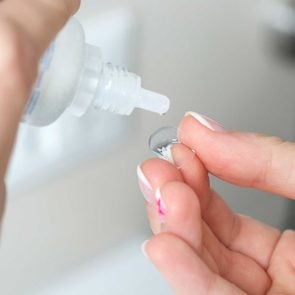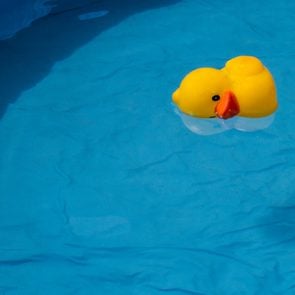Can You Swim With Contacts?
Updated: Oct. 26, 2021
The short answer is no. Contact lenses should never be exposed to water because of the potential harm to your eyes. Let's dive into why.
Can you swim in contacts?
When you’re in the water, you’re exposed to all sorts of germs. This is true no matter what type of water you’re in, including oceans, lakes, hot tubs, and pools. But wait—aren’t pools chlorinated? Yes, but they remain a common source of infection, including in the eyes.
In fact, the U.S. Centers for Disease Control and Prevention (CDC) found that more than 10 percent of public pools and other water recreation sites did not have adequate chlorine or bromine levels (a sanitizer used in warmer water) to keep harmful bacteria at bay.
The body’s immune system does a good job of fighting infection and keeping us from getting sick after germ exposure. But contact lenses pose particular challenges.
Here’s what you need to know about swimming in contacts.
Why don’t contacts and water mix well?
Contact lenses absorb water. This makes them swell, tighten, and stick to your eyes, which irritate them. It also may scratch your cornea, the clear protective dome that rests on the colored portion of your eye.
But the greater risk comes from all the bacteria in the water. When that water gets under your contacts, it’s then held against the eye, exposing your cornea to harm. The possible consequences range from mild to devastating, according to the CDC.
“People should never wear contacts when their eyes are exposed to water, as it greatly increases the risk of an eye infection, which can potentially be blinding,” says Matthew Gorski, MD, an ophthalmologist at Manhattan Ear, Eye, and Throat Hospital in New York.
“Luckily, these severe infections are rare, but mild infections are unfortunately fairly common.”
Maybe you’re thinking, “My eyes will be safe with contacts if I wear goggles in the water.” Dr. Gorski says no: “While goggles do a pretty good job of blocking water from your eyes, they are not 100 percent certain to prevent water from getting into your eyes,” he explains.
“You should never swim with contacts, even if wearing goggles.”
Dr. Gorski also advises against wearing contact lenses in the shower because that water also can harbor harmful bacteria. Wait until you’re out of the shower to put your contacts in.
Here are other showering mistakes you’re making.

What types of eye infections can occur?
Technically speaking, the answer to “can you swim in contacts” is yes. But should you swim in contacts? Again, that’s a hard no.
Dr. Gorski says a corneal ulcer, or an open sore on the cornea, is the most concerning type of eye infection related to wearing contact lenses. Though most often linked to bacteria, water-borne parasites also cause this type of infection.
Also called keratitis, it is the most common type of eye infection that occurs while wearing contact lenses. It can lead to scarring of the cornea. In severe cases, you may need a cornea transplant, according to the American Academy of Ophthalmology.
How do you recognize the signs of infection?
It will be hard to ignore the discomfort an eye infection causes. “It is extremely important to see your primary eye doctor if you develop any of these symptoms and keep the contacts out of your eye,” says Dr. Gorski, who lists the following signs of infection:
- pain
- redness
- irritation
- sensitivity to light
- decreased vision
- foreign body sensation, a feeling that there’s something in your eye
“Treatment usually involves a rigorous course with antibiotic drops,” says ophthalmologist Mark Fromer, MD, of Lenox Hill Hospital in New York City.
What increases the risk of infection?
“Any underlying eye condition that affects the surface of the eye—such as dry eye disease, recent eye surgery, or blepharitis, would make a person more susceptible to invasion of a bacteria or parasite and therefore increase the risk infection,” Dr. Gorski says.
And remember: Waterlogged contacts can lead to a scratched cornea. That makes it more susceptible to infection.
What types of bacteria and parasites cause harm?
“Acanthamoeba is a common organism found in water that can infect the eye when swimming with contact lenses,” Dr. Fromer says.
Acanthamoeba are often present in tap water, lake water, well water, and other water sources, according to the CDC.
It can cause a rare but painful and hard-to-treat eye infection called Acanthamoeba keratitis. The CDC estimates that contact lens wearers account for 85 percent of cases of this potentially blinding infection.
Dr. Fromer says two common types of bacteria infect contact lens wearers: Staphylococcus aureus and Pseudomonas aeruginosa. Both can lead to bacterial keratitis, an infection of the cornea. Untreated, it can quickly cause vision loss or blindness.
What should I do if I swam with contacts?
The first thing to do is remove your contacts and dispose of them. The U.S. Food and Drug Administration does not require that contact lens solution protects against Acanthamoeba.
Wait a few days before wearing contact lenses again, and use artificial tears during that time to flush your eyes. And be vigilant!
“It is important to monitor for signs of an infection and go to your eye doctor if any symptoms develop,” Dr. Gorski says.
Now that you know whether you can swim in contacts, check out these dangerous eye symptoms.













